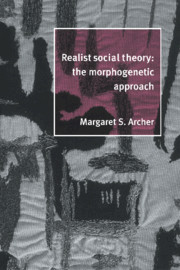Book contents
- Frontmatter
- Contents
- List of figures
- Acknowledgements
- 1 The vexatious fact of society
- Part I The problems of structure and agency: four alternative solutions
- Part II The morphogenetic cycle
- 6 Analytical dualism: the basis of the morphogenetic approach
- 7 Structural and cultural conditioning
- 8 The Morphogenesis of agency
- 9 Social elaboration
- Index
8 - The Morphogenesis of agency
Published online by Cambridge University Press: 02 December 2009
- Frontmatter
- Contents
- List of figures
- Acknowledgements
- 1 The vexatious fact of society
- Part I The problems of structure and agency: four alternative solutions
- Part II The morphogenetic cycle
- 6 Analytical dualism: the basis of the morphogenetic approach
- 7 Structural and cultural conditioning
- 8 The Morphogenesis of agency
- 9 Social elaboration
- Index
Summary
To talk about Social Agency at all means returning to the central problem presented by the ‘vexatious fact of society’ and its human constitution. That neither the structuring of society nor the social interaction responsible for it can be discussed in isolation from one another is the central tenet of the morphogenetic perspective. However in modern social theory there is nothing distinctive about endorsing this proposition which now commands near universal assent: what distinguishes between different approaches is how they conceptualize the interplay between what are generally known as ‘structure and agency’. The distinguishing feature of the morphogenetic perspective is its four-square endorsement of ‘analytical dualism’, namely, the idea that the two elements have to be teased out over time precisely in order to examine their interplay.
In the preceding two chapters, discussion of the morphogenesis of structure and culture relied upon social agents and their interaction as the mechanism which explained structural and cultural stability or change. Thus, the focus was on the results of interaction, which are passed up to the Structural and Cultural systems and passed on to subsequent generations of people as new conditioning influences upon them. All of this meant taking systemic outcomes as the focal point. Although it is perfectly legitimate to focus upon the remodelling of structure and culture in this way, it is equally important to recognize that the self-same sequence by which agency brings about social and cultural transformation is simultaneously responsible for the systematic transforming of social agency itself.
In other words, a ‘double morphogenesis’ is involved: agency leads to structural and cultural elaboration, but is itself elaborated in the process.
- Type
- Chapter
- Information
- Realist Social TheoryThe Morphogenetic Approach, pp. 247 - 293Publisher: Cambridge University PressPrint publication year: 1995



